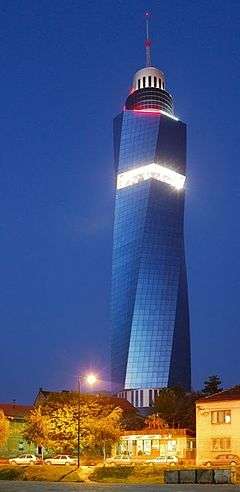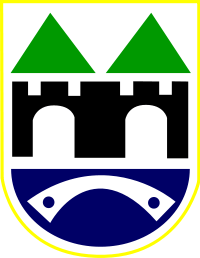History of modern Sarajevo
| History of Sarajevo |
|---|
|
Ancient times Middle Ages (7th–15th centuries) Early Ottoman era (15th–17th centuries) Late Ottoman era (17th–19th centuries) Sarajevo in Austria-Hungary (1878–1918) Yugoslav era (1918–1992) Modern and post-war (1992–present) |
| See also |
| Timeline of Sarajevo |

The history of modern Sarajevo begins with the declaration of independence of Bosnia and Herzegovina from Yugoslavia. The city then became the capital of the new state, as the local division of the Yugoslav People's Army established itself on the surrounding mountains. That day, massive peace protests took place. In the midst of the largest one, a protestor named Suada Dilberović was shot by unidentified gunmen from a nearby skyscraper.
The following three years found Sarajevo being the center of the longest siege in the history of modern warfare (See: Siege of Sarajevo). The city was held without electricity, heating, water, and medical supplies. During this whole time, the surrounding Serb forces shelled the city. An average of 329 shell impacts occurred per day, with a high of 3,777 shell impacts on July 22, 1993.
Asides from the economic and political structures that were destroyed, the besieger targeted numerous cultural sites. Thus places such as the Gazi Husrev-beg's Mosque, Cathedral of Jesus' Heart, and the Jewish cemetery were damaged, while places like the old City Hall and the Olympic museum were completely destroyed. For foreigners an event that defined the cultural objectives of the besiegers occurred during the night of August 25, 1992, the intentional shelling and utter destruction with incendiary shells of the irreplaceable Bosnia National and University Library, the central repository of Bosnian written culture, and a major cultural center of all the Balkans. Among the losses were about 700 manuscripts and incunabula and a unique collection of Bosnian serial publications, some from the middle of the 19th century Bosnian cultural revival. Libraries all over the world cooperated afterwards to restore some of the lost heritage, through donations and e-texts, rebuilding the Library in cyberspace.
It is estimated that 12,000 people were killed and another 50,000 wounded during the course of the siege. Through all this time however, the enemy forces were unable to decisively capture the city thanks to the effort of the Bosniak forces inside it. Following the Dayton Accords and a period of stabilization, the Bosnian government declared the siege officially over on February 29, 1996.
The next several years were a period of heavy reconstruction. During the siege, nearly every building in the city was damaged. Ruins were present throughout the city, and bullet holes were very common. Land mines were also located in the surroundings.
Thanks to foreign aid and domestic dedication, the city began a slow path to recovery. By 2003, there were practically no ruins in the city and bullet holes had become a rarity. Sarajevo was hosting numerous international events once again, such as the extremely successful Sarajevo Film Festival, and launched bids to hold the Winter Olympic Games in the city in the not so distant future.
Today Sarajevo is one of the fastest developing cities in the region. Various new modern buildings have been built, significantly the Bosmal City Center and the Avaz twist tower which is tallest skyscraper in the Balkans. A new highway was recently completed between Sarajevo and the city of Kakanj. The near-future for Sarajevo is hoped to hold continued development of the city, including construction of impressive modern buildings and population growth. The Sarajevo City Center will be one of the biggest and most modern Shopping and Business centers is South-East Europe when its gets completed 2012. If current growth trends continue, the Sarajevo metropolitan area should return to its pre-war population by 2020, with the city following soon after. At its current pace, Sarajevo won’t surpass the million resident mark until the second half of the 21st century. The most widely accepted and pursued goal was for the city to hold the Winter Olympics in 2014; that bid failed, so they will try again perhaps in 2022 or 2026.
Trebević ropeway (cable car) transportation system has been announced to be rebuilt following the use of the same during 1984 Winter Olympic Games. Trebević cable car was one of Sarajevo’s key landmarks. The cost involved will be 12,109.000[1] euros and it is planned to be competed by late 2016.[2] Cable cars and equipment have been donated by the Graechen ski centre in Wallis Canton, Switzerland. The selected cable cars are ideally suited to the project and meet the highest quality standards. The new Trebević cable car will have 6 sitting cabins and between 11 and 13 pillars, with a capacity to transport 1,200 passengers an hour. [3] Further monetary donations (approx 3,000,000 euros) have been made by Dutch national Edmond Offermann. [4][5]
External links
References
Notes
- ↑ "Sarajevo: Za obnovu trebevićke žičare potrebno još 5 miliona KM". faktor.ba. Retrieved 11 May 2015.
- ↑ "Trebevićka žičara: Grad do maja 2015. mora postaviti stubove". radiosarajevo.ba. Retrieved 6 January 2014.
- ↑ "Bosnia; Sarajevo to regain the Trebevic cable car!". bosniavolimte. Retrieved 17 July 2011.
- ↑ "Trebevićka žičara: Uskoro rješavanje imovinsko-pravnih odnosa". klix.ba. Retrieved 11 August 2015.
- ↑ "Fizičar Edmond Offermann donirao više od 3 miliona eura za Trebevićku žičaru". klix.ba. Retrieved 12 November 2013.

